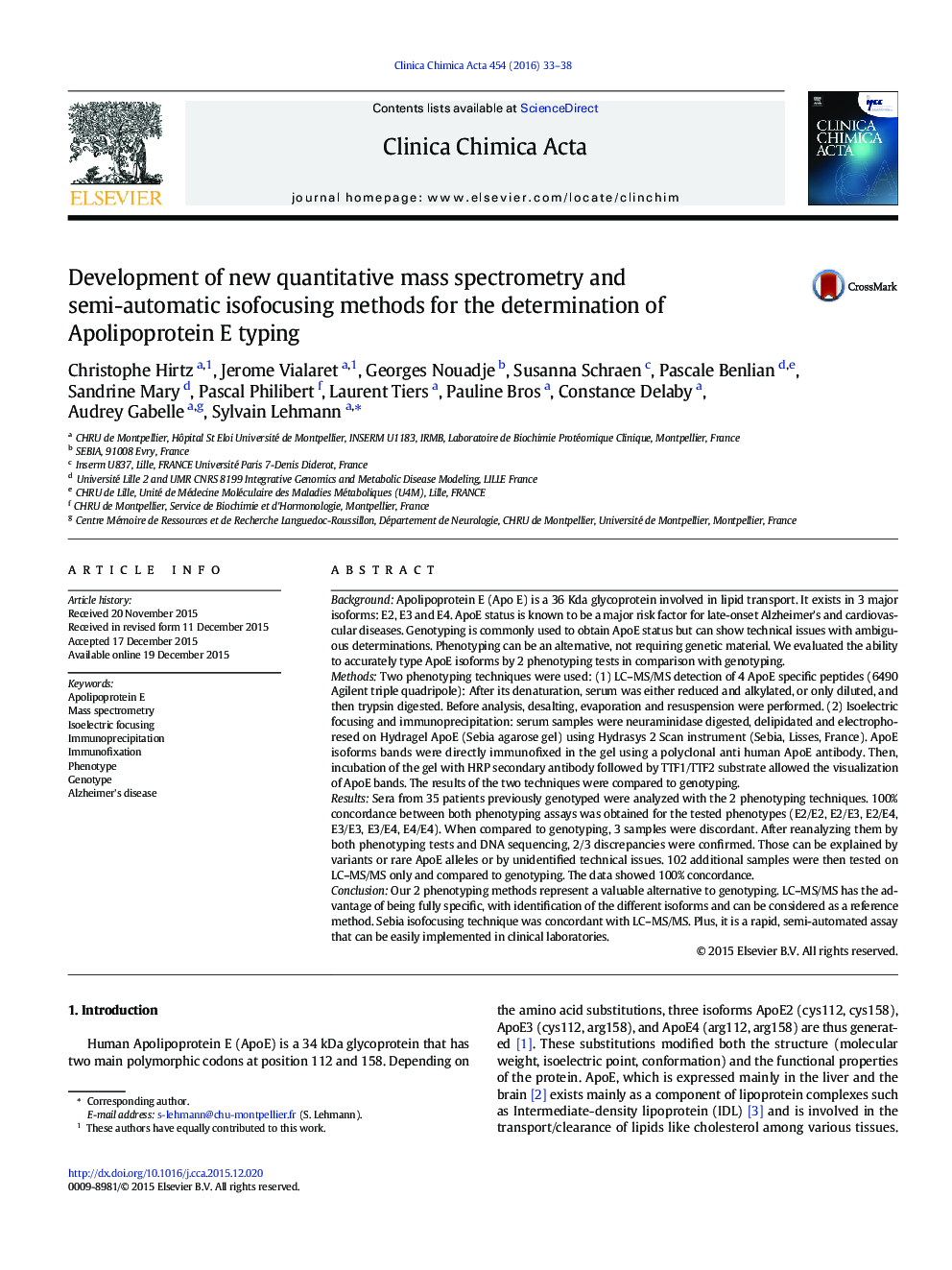| کد مقاله | کد نشریه | سال انتشار | مقاله انگلیسی | نسخه تمام متن |
|---|---|---|---|---|
| 1965168 | 1538645 | 2016 | 6 صفحه PDF | دانلود رایگان |
• A comparison of two complementary techniques (quantitative mass spectrometry and isofocusing) for the phenotyping of Apolipoprotein E is proposed.
• Apolipoprotein E known to be a major risk factor for late-onset Alzheimer's and cardiovascular diseases
• These 2 methods allow the of use small volume (2 to 20 μL) of residual blood from samples collected for routine clinical tests, thus enabling retrospective studies with preserved body fluids.
BackgroundApolipoprotein E (Apo E) is a 36 Kda glycoprotein involved in lipid transport. It exists in 3 major isoforms: E2, E3 and E4. ApoE status is known to be a major risk factor for late-onset Alzheimer's and cardiovascular diseases. Genotyping is commonly used to obtain ApoE status but can show technical issues with ambiguous determinations. Phenotyping can be an alternative, not requiring genetic material. We evaluated the ability to accurately type ApoE isoforms by 2 phenotyping tests in comparison with genotyping.MethodsTwo phenotyping techniques were used: (1) LC–MS/MS detection of 4 ApoE specific peptides (6490 Agilent triple quadripole): After its denaturation, serum was either reduced and alkylated, or only diluted, and then trypsin digested. Before analysis, desalting, evaporation and resuspension were performed. (2) Isoelectric focusing and immunoprecipitation: serum samples were neuraminidase digested, delipidated and electrophoresed on Hydragel ApoE (Sebia agarose gel) using Hydrasys 2 Scan instrument (Sebia, Lisses, France). ApoE isoforms bands were directly immunofixed in the gel using a polyclonal anti human ApoE antibody. Then, incubation of the gel with HRP secondary antibody followed by TTF1/TTF2 substrate allowed the visualization of ApoE bands. The results of the two techniques were compared to genotyping.ResultsSera from 35 patients previously genotyped were analyzed with the 2 phenotyping techniques. 100% concordance between both phenotyping assays was obtained for the tested phenotypes (E2/E2, E2/E3, E2/E4, E3/E3, E3/E4, E4/E4). When compared to genotyping, 3 samples were discordant. After reanalyzing them by both phenotyping tests and DNA sequencing, 2/3 discrepancies were confirmed. Those can be explained by variants or rare ApoE alleles or by unidentified technical issues. 102 additional samples were then tested on LC–MS/MS only and compared to genotyping. The data showed 100% concordance.ConclusionOur 2 phenotyping methods represent a valuable alternative to genotyping. LC–MS/MS has the advantage of being fully specific, with identification of the different isoforms and can be considered as a reference method. Sebia isofocusing technique was concordant with LC–MS/MS. Plus, it is a rapid, semi-automated assay that can be easily implemented in clinical laboratories.
Journal: Clinica Chimica Acta - Volume 454, 15 February 2016, Pages 33–38
